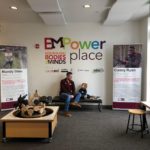DARBY LACY’S VETERAN VISTA ADVICE
August 15, 2017
 |
| MTCC VISTA Alumna, Darby Lacy. |
Darby Lacy just completed a year of service with the Bozeman Area Community Foundation. She agreed to share some reflections with our incoming members. Thanks Darby!
________________________________
“As I began my year of service a little over a year ago, I remember feeling as if I had so many days to fill with activities to strengthen my community. I also had no clue where to start. Upon reflection, a few principles and practices helped me find my footing for a meaningful year of service – which went by quicker than I could have ever imagined.
Even though I stayed in my community to serve, I had relatively little experience with the conventions of nonprofit work or what work nonprofits in my community were carrying out. My first weeks were filled with reading as much as possible about my organization and community. This would be my first piece of advice to new VISTAs: Learn as much as possible about your community and your organization. Read books! Read the newspaper! Read community blogs! Go to city or tribal council meetings! Meet with community leaders! Information is everywhere. Guiding questions for this search include: What are the challenges is your community facing? What are the main economic drivers? Who is getting stuff done in the community? Who’s voices are and aren’t being heard?
I also made it a priority to meet every one of our board members for coffee during my first month of service, something I would highly recommend. I asked them questions about: why they were compelled to join the board, what they were proud of about our organization, and what they saw as our growth opportunities. I learned a tremendous amount about important moments in my organization’s history and goals for the upcoming year. I also built relationships with folks who provided guidance, feedback, and support during my year of service. This would be an equally great practice for connecting with other VISTAs, service members, and other community leaders. VISTA projects are strengthened by collaboration outside of your site, and this practice lays groundwork for that critical collaboration. Ultimately, it also helps you feel more connected to your project and potentially new home.
Another important lesson I learned was that I didn’t have to start from scratch in my service even though I was creating a new process for my organization. I recommend not completely reinventing the wheel, but also innovating an approach that suites your community. Guiding questions here are: What’s working in other organizations similar to yours? What is unique about my community’s needs?
Finally, VISTA is all about poverty alleviation. You will be asked by VISTA to keep track of certain statistics about your service impact, and you should consider what statistics are important to your organization as well. Figure out what you want to measure and how you will measure it before you start a new program or process. This will help you share the incredible impact of your work with funders, government agencies, and community members so that your work can be supported and sustained after your time as a VISTA ends.
Perhaps the advice I’ve shared is a tell; I’m a person who believes that planning and research are necessary before diving into any project. To leave a strong VISTA legacy, I believe this information gathering and planning stage is critical work even when it feels like nothing tangible is being completed. Research and planning will allow you to build a stable foundation for VISTA projects that sustainably meet your community’s and organization’s needs. Of course flexibility, creativity, and innovation are just as necessary when plans fall through. Being well researched, in tune with your community, and open minded will prove invaluable when you are called upon to change directions in the middle of things, because inevitably you will be.
Good luck! Wishing you all the best on your VISTA journey!”
 Campus Compact Blog
Campus Compact Blog 
